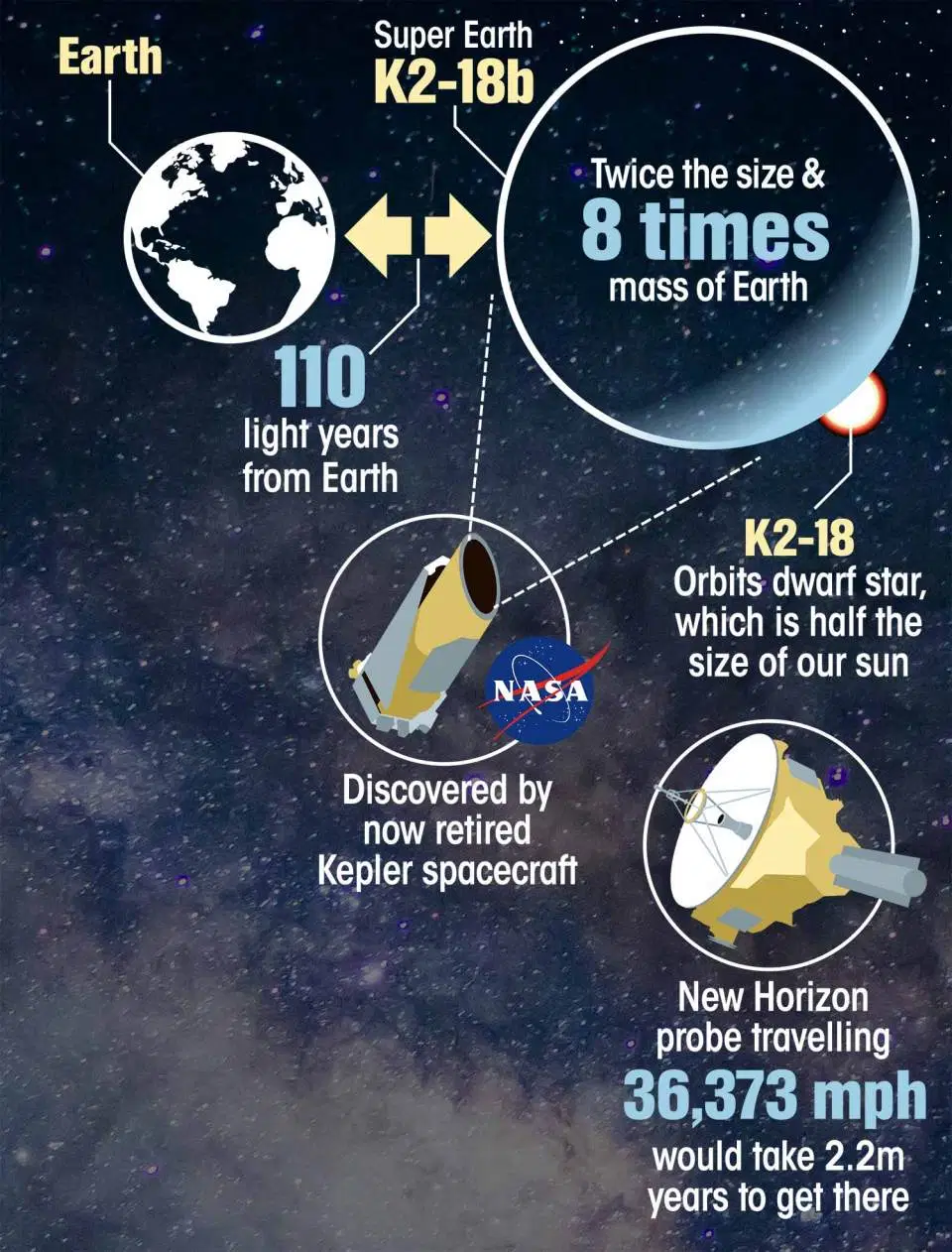And K2-18b's air is also rich in DMS and/or DMDS, according to the new study. The researchers estimate concentrations of more than 10 parts per million by volume, compared to less than one part
JWST May Have Found Strongest Evidence of Life on Exoplanet K2-18b While cautious about the findings, astronomers detected traces of a chemical that, on Earth, is produced by phytoplankton.
K2-18b, which is 2.6 times the size of our planet and 8.6 times the mass, is suspected to be a "hycean world," meaning that it potentially has a planet-wide ocean and an atmosphere rich in hydrogen.
Previous data of K2-18b, obtained with Webb's Near-Infrared Imager and Slitless Spectrograph and Near-Infrared Spectrograph, shows an abundance of methane and carbon dioxide in the exoplanet's
Data from the James Webb Space Telescope (JWST) has shown that exoplanet K2-18b has some of the chemical markers that may indicate life.
JWST May Have Found Strongest Evidence of Life on Exoplanet K2-18b While cautious about the findings, astronomers detected traces of a chemical that, on Earth, is produced by phytoplankton. K2-18b, which is 2.6 times the size of our planet and 8.6 times the mass, is suspected to be a "hycean world," meaning that it potentially has a planet-wide ocean and an atmosphere rich in hydrogen. Previous data of K2-18b, obtained with Webb's Near-Infrared Imager and Slitless Spectrograph and Near-Infrared Spectrograph, shows an abundance of methane and carbon dioxide in the exoplanet's Data from the James Webb Space Telescope (JWST) has shown that exoplanet K2-18b has some of the chemical markers that may indicate life.
A paper published in 2023 spurred discussion about whether life exists on an exoplanet named K2-18b. Two years later, the puzzle continues — and some scientists are expressing doubt.
This artist's concept shows what exoplanet K2-18 b could look like based on science data. K2-18 b, an exoplanet 8.6 times as massive as Earth, orbits the cool dwarf star K2-18 in the habitable zone and lies 120 light-years from Earth. A new investigation with NASA's James Webb Space Telescope into K2-18 b has revealed the presence of carbon-bearing molecules including methane and carbon
Astronomers find possible signs of alien life on massive, distance planet K2-18b. The exoplanet K2-18b is 8 times bigger than planet Earth. The claim about alien life involved data from NASA's
Earlier observations found methane and carbon dioxide in K2-18b's atmosphere — the first instance of carbon-based molecules discovered in the atmosphere of an exoplanet in the habitable zone. K2-18b is about 2.6 times as large as Earth, and lies 124 light years away, in the constellation Leo.
JWST May Have Found Strongest Evidence of Life on Exoplanet K2-18b
A paper published in 2023 spurred discussion about whether life exists on an exoplanet named K2-18b. Two years later, the puzzle continues — and some scientists are expressing doubt. This artist's concept shows what exoplanet K2-18 b could look like based on science data. K2-18 b, an exoplanet 8.6 times as massive as Earth, orbits the cool dwarf star K2-18 in the habitable zone and lies 120 light-years from Earth. A new investigation with NASA's James Webb Space Telescope into K2-18 b has revealed the presence of carbon-bearing molecules including methane and carbon Astronomers find possible signs of alien life on massive, distance planet K2-18b.
The exoplanet K2-18b is 8 times bigger than planet Earth. The claim about alien life involved data from NASA's Earlier observations found methane and carbon dioxide in K2-18b's atmosphere — the first instance of carbon-based molecules discovered in the atmosphere of an exoplanet in the habitable zone. K2-18b is about 2.6 times as large as Earth, and lies 124 light years away, in the constellation Leo.
K2-18b, also known as EPIC 201912552 b, is an exoplanet orbiting the red dwarf K2-18, located 124 light-years (38 pc) away from Earth. The planet is a sub-Neptune about 2.6 times the radius of Earth, with a 33-day orbit within the star's habitable zone; it receives approximately a similar amount of light as the Earth receives from the Sun.
The team sidestepped this challenge by analyzing light from K2-18 b's parent star as it passed through the exoplanet's atmosphere. K2-18 b is a transiting exoplanet, meaning that we can detect a drop in brightness as it passes across the face of its host star. This is how the exoplanet was first discovered in 2015 with NASA's K2 mission.
K2-18 ist ein Roter Zwerg in einer Entfernung von 124 Lichtjahren von der Erde. In der habitablen Zone dieses Sterns wurde im Jahr 2015 mithilfe des Weltraumteleskops Kepler ein Exoplanet im Format einer sogenannten Supererde oder eines Mini-Neptuns entdeckt, der die Bezeichnung K2-18b erhielt. [4] Die Atmosphäre dieses Planeten wird intensiv untersucht und zeigt Spuren mehrerer interessanter
K2-18b, an exoplanet 120 light-years away, may be the best hope to confirm that life exists beyond Earth. Here's what to know.
Could life thrive on K2-18b? What to know about the distant exoplanet
K2-18b, also known as EPIC 201912552 b, is an exoplanet orbiting the red dwarf K2-18, located 124 light-years (38 pc) away from Earth. The planet is a sub-Neptune about 2.6 times the radius of Earth, with a 33-day orbit within the star's habitable zone; it receives approximately a similar amount of light as the Earth receives from the Sun. The team sidestepped this challenge by analyzing light from K2-18 b's parent star as it passed through the exoplanet's atmosphere. K2-18 b is a transiting exoplanet, meaning that we can detect a drop in brightness as it passes across the face of its host star. This is how the exoplanet was first discovered in 2015 with NASA's K2 mission.
K2-18 ist ein Roter Zwerg in einer Entfernung von 124 Lichtjahren von der Erde. In der habitablen Zone dieses Sterns wurde im Jahr 2015 mithilfe des Weltraumteleskops Kepler ein Exoplanet im Format einer sogenannten Supererde oder eines Mini-Neptuns entdeckt, der die Bezeichnung K2-18b erhielt. [4] Die Atmosphäre dieses Planeten wird intensiv untersucht und zeigt Spuren mehrerer interessanter K2-18b, an exoplanet 120 light-years away, may be the best hope to confirm that life exists beyond Earth. Here's what to know.
The K2-18b Planetary System: Estimates of the Age and X-UV Irradiances of a Habitable Zone "Wet" Sub-Neptune Planet 2019 GUINAN E. & ENGIE S. Res. Notes AAS , 3 , 189 paper The CARMENES Search for Exoplanets around M Dwarfs: A Low-mass Planet in the Temperate Zone of the Nearby K2-18
K2-18b is considered a Hycean exoplanet - as opposed to a rocky planet - due to its potential to possess a hydrogen-rich atmosphere and surface covered in ocean water Since it was discovered
The planet K2-18b orbits its dim red host star in an illustration. This exoplanet is the first of its kind known to host water vapor in its atmosphere. Illustration by M. Kornmesser, ESA/Hubble.
With data from the NASA/ESA Hubble Space Telescope, water vapour has been detected in the atmosphere of a super-Earth within the habitable zone by University College London (UCL) researchers in a world first. K2-18b, which is eight times the mass of Earth, is now the only planet orbiting a star outside the Solar System, or exoplanet, known to have both water and temperatures that could support
Hubble Finds Water Vapour on Habitable-Zone Exoplanet for the First
The K2-18b Planetary System: Estimates of the Age and X-UV Irradiances of a Habitable Zone "Wet" Sub-Neptune Planet 2019 GUINAN E. & ENGIE S. Res. Notes AAS , 3 , 189 paper The CARMENES Search for Exoplanets around M Dwarfs: A Low-mass Planet in the Temperate Zone of the Nearby K2-18 K2-18b is considered a Hycean exoplanet - as opposed to a rocky planet - due to its potential to possess a hydrogen-rich atmosphere and surface covered in ocean water Since it was discovered The planet K2-18b orbits its dim red host star in an illustration. This exoplanet is the first of its kind known to host water vapor in its atmosphere.
Illustration by M. Kornmesser, ESA/Hubble. With data from the NASA/ESA Hubble Space Telescope, water vapour has been detected in the atmosphere of a super-Earth within the habitable zone by University College London (UCL) researchers in a world first. K2-18b, which is eight times the mass of Earth, is now the only planet orbiting a star outside the Solar System, or exoplanet, known to have both water and temperatures that could support
"Goldilocks" zone. More than eight times the mass of Earth and 2.5 times as big, K2-18b is rare among the roughly 6,000 exoplanets discovered so far in that it orbits its star in a habitable or
K2-18b resides within the habitable zone of its star, making the presence of liquid water and thus life possible. Using the James Webb Space Telescope, researchers detected molecules in K2-18b's
Editor's note: This article on K2-18b was first published in September 2023 on The Conversation. The Times of London reported NASA's James Webb Space Telescope was to further investigate the
Life on exoplanet K2-18b? In 2023, scientists announced they had tentatively identified the gas dimethyl sulfide - a possible biosignature of life - in the atmosphere of K2-18b, an exoplanet
Life on K2-18b? Exciting new results met with skepticism - EarthSky
"Goldilocks" zone. More than eight times the mass of Earth and 2.5 times as big, K2-18b is rare among the roughly 6,000 exoplanets discovered so far in that it orbits its star in a habitable or K2-18b resides within the habitable zone of its star, making the presence of liquid water and thus life possible. Using the James Webb Space Telescope, researchers detected molecules in K2-18b's Editor's note: This article on K2-18b was first published in September 2023 on The Conversation. The Times of London reported NASA's James Webb Space Telescope was to further investigate the Life on exoplanet K2-18b? In 2023, scientists announced they had tentatively identified the gas dimethyl sulfide - a possible biosignature of life - in the atmosphere of K2-18b, an exoplanet
Webb Telescope's study on K2-18b reveals potential but inconclusive signs of extraterrestrial life; advanced technology needed for certainty.
K2-18b, which orbits a red dwarf star more than 120 light-years from Earth, has for years intrigued astronomers who believe it exists in what they refer to as the "habitable zone" - where
A Cambridge team studying the atmosphere of a planet called K2-18b has detected signs of molecules which on Earth are only produced by simple organisms.
K2-18b is a planet with mass roughly 8.6 times that of Earth and a radius 2.6 times larger-sitting in an interesting middle ground between rocky planets and gas giants. Since its initial discovery in 2015 by Kepler Space Telescope, the exoplanet had not been considered as potential, while having the capacity of hosting life, until recent
The JWST Has Detected Signs of Life on K2-18B, 120 Light-Years Away
Webb Telescope's study on K2-18b reveals potential but inconclusive signs of extraterrestrial life; advanced technology needed for certainty. K2-18b, which orbits a red dwarf star more than 120 light-years from Earth, has for years intrigued astronomers who believe it exists in what they refer to as the "habitable zone" - where A Cambridge team studying the atmosphere of a planet called K2-18b has detected signs of molecules which on Earth are only produced by simple organisms. K2-18b is a planet with mass roughly 8.6 times that of Earth and a radius 2.6 times larger-sitting in an interesting middle ground between rocky planets and gas giants. Since its initial discovery in 2015 by Kepler Space Telescope, the exoplanet had not been considered as potential, while having the capacity of hosting life, until recent




